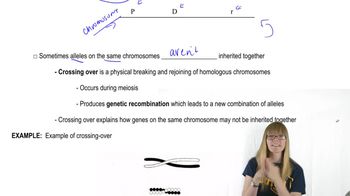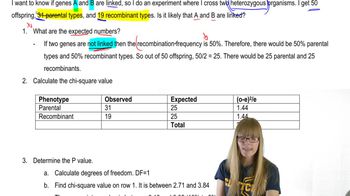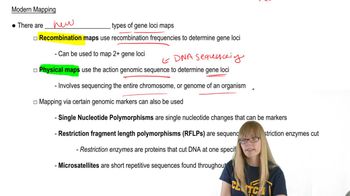Table of contents
- 1. Introduction to Genetics51m
- 2. Mendel's Laws of Inheritance3h 37m
- 3. Extensions to Mendelian Inheritance2h 41m
- 4. Genetic Mapping and Linkage2h 28m
- 5. Genetics of Bacteria and Viruses1h 21m
- 6. Chromosomal Variation1h 48m
- 7. DNA and Chromosome Structure56m
- 8. DNA Replication1h 10m
- 9. Mitosis and Meiosis1h 34m
- 10. Transcription1h 0m
- 11. Translation58m
- 12. Gene Regulation in Prokaryotes1h 19m
- 13. Gene Regulation in Eukaryotes44m
- 14. Genetic Control of Development44m
- 15. Genomes and Genomics1h 50m
- 16. Transposable Elements47m
- 17. Mutation, Repair, and Recombination1h 6m
- 18. Molecular Genetic Tools19m
- 19. Cancer Genetics29m
- 20. Quantitative Genetics1h 26m
- 21. Population Genetics50m
- 22. Evolutionary Genetics29m
4. Genetic Mapping and Linkage
Mapping Genes
Problem 37
Textbook Question
For six genes known to be linked on chromosome 10 of corn (Zea mays), the recombination frequencies between various pairs have been determined in a series of genetic crosses. Use the recombination frequency data in the table below to determine the order of and distance between the genes on a genetic map. The gene lc1 is known to be closest to the telomere of the chromosome.
 Verified step by step guidance
Verified step by step guidance1
Identify the gene closest to the telomere, which is given as lc1.
List all the genes and their recombination frequencies with each other from the provided data.
Start with the gene lc1 and find the gene with the smallest recombination frequency to lc1, indicating it is the closest neighbor.
Continue adding genes to the map by selecting the next smallest recombination frequency with the last added gene, ensuring to check for consistency with previously mapped genes.
Calculate the genetic distances between each pair of adjacent genes on the map using the recombination frequencies, converting them into map units (centimorgans).
Recommended similar problem, with video answer:
 Verified Solution
Verified SolutionThis video solution was recommended by our tutors as helpful for the problem above
Video duration:
2mPlay a video:
Was this helpful?
Key Concepts
Here are the essential concepts you must grasp in order to answer the question correctly.
Recombination Frequency
Recombination frequency is a measure of the likelihood that two genes located on the same chromosome will be separated during meiosis due to crossing over. It is expressed as a percentage, representing the proportion of recombinant offspring produced in a genetic cross. Higher recombination frequencies indicate that genes are further apart on the chromosome, while lower frequencies suggest they are closer together.
Recommended video:
Guided course

Recombination after Single Strand Breaks
Genetic Mapping
Genetic mapping is the process of determining the relative positions of genes on a chromosome. This is achieved by analyzing recombination frequencies between pairs of genes, which allows researchers to create a linear representation of gene order and distances. Genetic maps are essential for understanding gene linkage and inheritance patterns in organisms.
Recommended video:
Guided course

Mapping Overview
Linkage and Gene Order
Linkage refers to the tendency of genes located close to each other on the same chromosome to be inherited together during meiosis. The order of linked genes can be determined by analyzing recombination frequencies; genes that are more likely to recombine are further apart, while those that are less likely to recombine are closer together. Understanding gene order is crucial for constructing accurate genetic maps.
Recommended video:
Guided course

Chi Square and Linkage
Related Videos
Related Practice





